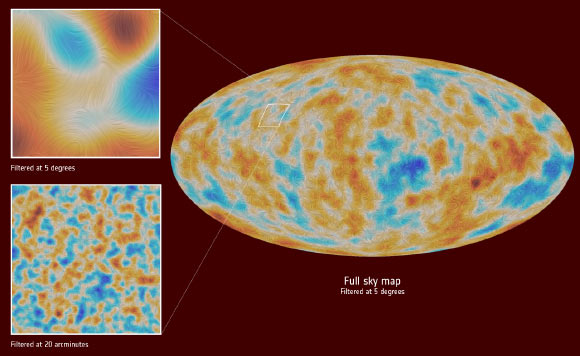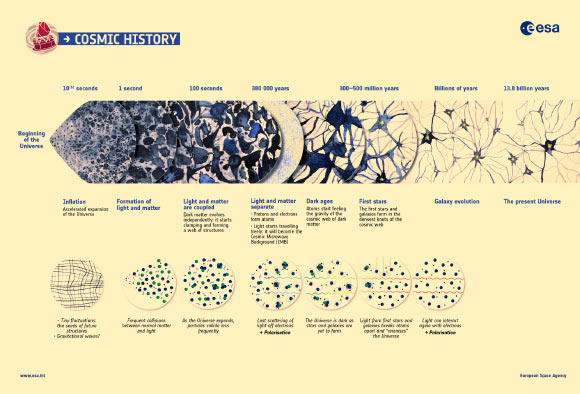Thanks to new data from European Space Agency’s Planck space telescope, researchers have found that the reionization – one of the most important processes in cosmology as it is associated with the formation of the first stars – occurred 550 million years after the Big Bang, approximately 100 million years later than previously thought.

A visualization of the polarization of the CMB, as detected by Planck. The CMB is a snapshot of the oldest light in our Universe, imprinted on the sky when the Universe was just 380,000 years old. It shows tiny temperature fluctuations that correspond to regions of slightly different densities, representing the seeds of all future structure: the stars and galaxies of today. A small fraction of the CMB is polarized – it vibrates in a preferred direction. This is a result of the last encounter of this light with electrons, just before starting its cosmic journey. For this reason, the polarization of the CMB retains information about the distribution of matter in the early Universe, and its pattern on the sky follows that of the tiny fluctuations observed in the temperature of the CMB. In these images, the color scale represents temperature differences in the CMB, while the texture indicates the direction of the polarized light. The patterns seen in the texture are characteristic of E-mode polarization, which is the dominant type for the CMB. The large oval shows the CMB polarization as seen by Planck on the entire sky. For the sake of illustration, both data sets have been filtered to show mostly the signal detected on scales around 5° on the sky. However, fluctuations in both the CMB temperature and polarization are present and were observed by Planck also on larger as well as smaller angular scales. To provide a taste of the fine structure of the measurement obtained by Planck, a zoomed-in view on a smaller patch of the sky, measuring 20° across, is also provided on the left. This is first shown with the same filtering as the all-sky image (upper frame), then with a different filter that shows mostly the signal detected on angles on the sky of about 20 arcminutes (lower frame). Image credit: ESA / Planck Collaboration.
The history of Universe is a 13.8 billion-year tale that cosmologists endeavor to read by studying the planets, asteroids, comets and other objects in our Solar System, and gathering light emitted by distant stars, galaxies and the matter spread between them.
A major source of information used to piece together this story is the Cosmic Microwave Background (CMB).
CMB is the fossil light resulting from a time when the Universe was hot and dense, only 380,000 years after the Big Bang.
Thanks to the expansion of the Universe, scientists see this light today covering the whole sky at microwave wavelengths.
Between 2009 and 2013, Planck spacecraft surveyed the sky to study this light in unprecedented detail.
Tiny differences in the background’s temperature trace regions of slightly different density in the early cosmos, representing the seeds of all future structure, the stars and galaxies of today.
“But there is more: the CMB carries additional clues about our cosmic history that are encoded in its polarization. Planck has measured this signal for the first time at high resolution over the entire sky, producing the unique maps released today,” said Dr Jan Tauber, ESA’s Planck project scientist.
Light is polarized when it vibrates in a preferred direction, something that may arise as a result of photons bouncing off other particles. This is exactly what happened when the CMB originated in the early Universe.
Initially, photons were trapped in a hot, dense soup of particles that, by the time the Universe was a few seconds old, consisted mainly of electrons, protons and neutrinos. Owing to the high density, electrons and photons collided with one another so frequently that light could not travel any significant distant before bumping into another electron, making the early Universe extremely foggy.

A summary of the 13.8 billion year history of the Universe, showing in particular the events that contributed to the Cosmic Microwave Background (CMB). The processes depicted range from inflation, the brief era of accelerated expansion that the Universe underwent when it was a tiny fraction of a second old, to the release of the CMB, the oldest light in our Universe, imprinted on the sky when the cosmos was just 380,000 years old; and from the Dark Ages to the birth of the first stars and galaxies, which reionized the Universe when it was a few hundred million years old, all the way to the present time. Tiny quantum fluctuations generated during the inflationary epoch are the seeds of future structure: the stars and galaxies of today. After the end of inflation, dark matter particles started to clump around these cosmic seeds, slowly building a cosmic web of structures. Later, after the release of the CMB, normal matter started to fall into these structures, eventually giving rise to stars and galaxies. The inserts below show a zoomed-in view on some of the microscopic processes taking place during cosmic history: from the tiny fluctuations generated during inflation, to the dense soup of light and particles that filled the early Universe; from the last scattering of light off electrons, which gave rise to the CMB and its polarization, to the reionization of the Universe, caused by the first stars and galaxies, which induced additional polarization on the CMB. Image credit: ESA.
Slowly but surely, as the cosmos expanded and cooled, photons and the other particles grew farther apart, and collisions became less frequent.
This had two consequences: electrons and protons could finally combine and form neutral atoms without them being torn apart again by an incoming photon, and photons had enough room to travel, being no longer trapped in the cosmic fog.
Once freed from the fog, the light was set on its cosmic journey that would take it all the way to the present day, where telescopes like Planck detect it as the CMB. But the light also retains a memory of its last encounter with the electrons, captured in its polarization.
Polarization data from the space telescope confirm the details of the standard cosmological picture determined from its measurement of the CMB temperature fluctuations.
But the data also add a new answer to a fundamental question: when were the first stars born?
Planck’s observations of the CMB polarization show that the so-called Dark Ages ended some 550 million years after the Big Bang.
The Dark Ages ended as the first stars began to shine. And as their light interacted with gas in the Universe, more and more of the atoms were turned back into their constituent particles: electrons and protons. This phase in the history of Universe is known as the Epoch of Reionization.
The newly liberated electrons were once again able to collide with the light from the CMB, albeit much less frequently now that the Universe had significantly expanded.
Nevertheless, just as they had 380,000 years after the Big Bang, these encounters between electrons and photons left a tell-tale imprint on the polarization of the CMB.
“From our measurements of the most distant galaxies and quasars, we know that the process of reionization was complete by the time that the Universe was about 900 million years old. But, at the moment, it is only with the CMB data that we can learn when this process began,” said Dr George Efstathiou from the University of Cambridge, UK.
The new results, presented in a series of twenty eight papers – most of which will be published in the journal Astronomy & Astrophysics, are critical, because previous studies of the CMB polarization seemed to point towards an earlier dawn of the first stars, placing the beginning of reionisation about 450 million years after the Big Bang.
_____
P.A.R. Ade et al. 2015. Planck 2015 results. III. LFI systematic uncertainties. A&A, in preparation;
P.A.R. Ade et al. 2015. Planck 2015 results. V. LFI calibration. A&A, in preparation;
R. Adam et al. 2015. Planck 2015 results. IX. Diffuse component separation: CMB maps. A&A, submitted for publication;
R. Adam et al. 2015. Planck 2015 results. XI. CMB power spectra, likelihood, and consistency of cosmological parameters. A&A, in preparation;
R. Adam et al. 2015. Planck 2015 results. XII. Simulations. A&A, in preparation;
P.A.R. Ade et al. 2015. Planck 2015 results. XVI. Isotropy and statistics of the CMB. A&A, in preparation;
P.A.R. Ade et al. 2015. Planck 2015 results. XX. Constraints on inflation. A&A, submitted for publication;
Planck 2015 results. XXIII. Thermal Sunyaev-Zeldovich effect–cosmic infrared background correlation. A&A, in preparation;
Planck 2015 results. XXV. Diffuse, low-frequency Galactic foregrounds. A&A, in preparation;
Planck 2015 results. XXVI. The Second Planck Catalogue of Compact Sources. A&A, in preparation;







